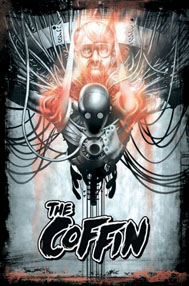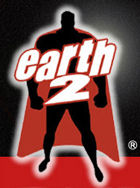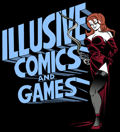| Graphic
Depictions: The Coffin
Robert
returns this week with another look at a book you probably
missed, but for the record, Hollywood hasn't. Plans are afoot
for a film version of The Coffin, and once you read Robert's
review, you'll understand why.
Is there
an afterlife? Does the human soul exist? Do our bastards go
to Hell and our saints to Heaven? Thanks to Oni Press, we
now have the answers to these questions in the form of The
Coffin, written by Phil Hester and drawn by Mike Huddleston.
This
graphic novel is the tale of Ashar Ahmad: genius scientist,
apparent atheist, and cold-blooded jerk. Along with his assistant
Liv (who just happens to be the mother of his young daughter
Billie, a familial responsibility he chooses to ignore), Ahmad
has designed and created an impermeable, strong membrane that
he claims can trap a soul after the death of the human body.
Along with a CPU attached to the membrane's shell that sends
electrical impulses along the membrane causing it to constrict
and retract, these suits, or "coffins," can simulate human
movement. Effectively, Ahmad has created a way to become immortal.
Now enters the scary-bad-guy.
The man
who has been providing Ahmad with his generous funding is
Oliver Heller, C.E.O. of HellerTech, and the world's oldest
man at one hundred and forty years old. How did he get this
old, you ask? Why yes, it is the most disgusting way
possible: he kills people and takes their organs, then has
them transplanted into his body.
Heller
has been looking for a way to cheat death and may have found
it in Ahmad's research. Fearing Ahmad would take the research
and sell it to someone else, Heller sends two of his most
loyal employees (and by "loyal" I mean "sociopathic") to kill
Ahmad and Liv and steal the research.
They
succeed, putting two bullets in Ahmad and leaving him for
dead while they set explosives and finish off Liv. While the
two employees escape, Ahmad drags himself to a vat of his
soul-trapping polymer, where a prototype coffin waits for
him. He dives in and it all goes black.
Now come
the theological upheavals. Ahmad expected to die and see nothing.
Imagine his surprise when he finds himself in a Dante-like
version of Hell, complete with tortured souls and probably
the most interesting rendition of Satan to ever appear in
comic books. The Devil (who is never actually saddled with
a name or moniker; neither is "Hell" for that matter) takes
Ahmad on a small tour of the inferno, all the while assuring
Ahmad that it doesn't matter what he believed in: Hell is
the reality.
But Ahmad
isn't dead yet, as his former lover/assistant Liv tells him
when she appears to him in this afterlife. He has a chance
to go back and do it better, to live a better life than before.
"Come on, didn't you ever read A Christmas Carol?" she asks.
And he goes back.
Ahmad
emerges from the tank, clad in his polymer "coffin," physically
dead, spiritually burdened, and wanting nothing more than
to find his daughter. But when Heller discovers that Ahmad
is alive and needed to accurately reproduce the soul-stopping
polymer, Ahmad becomes a target, and so does Billie. Ahmad
has to get his daughter back and stop Heller, and through
all this, maybe find his path to redemption.
The theological
questions Hester raise in this book are ones that have plagued
the modern cynic for a long time. We can call ourselves "atheist"
and "agnostic" and claim to have no great fear of the afterlife,
because to us there isn't one, but there is still that lingering
question of "What if…"
Ahmad
is the prime example of a character that has the belief-structure-rug
pulled out from under him. A scientist, a man of thought and
reason, he couldn't be expected to waste time being "good,"
and worrying about some intangible higher power when there
was work to be done. But then he dies and finds that all his
reason and rational analysis of the world means nothing.
We are
all pieces on a chessboard, pawns to be moved by divine powers,
of which we have little understanding and never truly will
understand, perhaps, until our own deaths. Hester perpetuates
this theme of fate and divine power throughout the book by
making Ahmad question if what he saw in his "near-death experience"
was an oxygen-deprived hallucination or actual divine warning,
though he does give Ahmad the choice to determine his own
fate at one juncture in the book, perhaps proving that spiritual
freedom still exists, even in the face of destiny.
But besides
all this theology, Hester writes a fantastic horror story.
Parts of this book are utterly disturbing in their grotesque
depictions and startling twists. Almost all the characters
are immoral in some capacity, save the daughter and one other,
and they all act the part. To kill, in this book, is common,
and one scene will teach everyone who reads it a new word:
"pithing." You may have nightmares about this word.
The images
of Hell Hester creates with Huddleston are frightening, picturing
writhing skeletons, crucifixions, and a stark white background
that makes Hell appear infinitely large. Huddleston is perfect
for this dark story. His pencils and inking are expertly done
and very detailed. He plays with shadows and negative space
better than most modern-day inkers, creating a macabre, almost
cinematic look for the book that adds volumes of sub-meaning
to every panel.
This
book is exceptionally good, though it flew under the radar
of many comic book readers due to it being in black and white.
That and Oni Press doesn't get a lot of shelf space compared
to DC or Marvel comics. They missed a great read then, but
they now have to option of reading the trade-paperback edition,
priced affordably at $11.95. So, pick this book up, take it
to the man with the register, and exchange little, green pieces
of paper for it. And then give the change to a charity or
something. You never know when some good karma will save your
soul from eternal damnation.
Or
order it on-line, providing for some Fanboy Karma: The
Coffin
|






